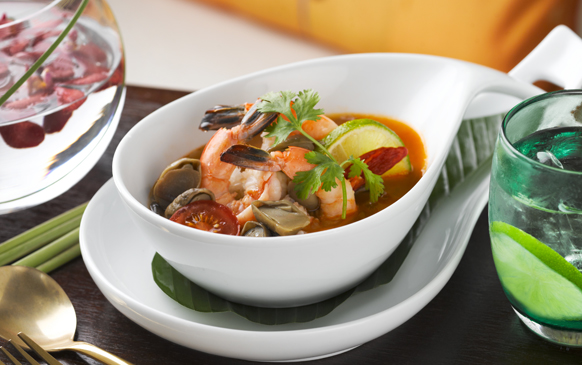The Seychelles, as they say, is for lovers. The Indian Ocean archipelago is a tropical idyll where lapping waves and swaying palms await star-crossed lovers; where pristine beaches and lavish resorts encircle the many sun-drenched islands. But the object of the heart’s affection can vary according to the fickle fancies of the stomach, and visitors are just as likely to fall head over heels for what’s on the menu as they are for the destination itself.
The Seychelles is a truly dichotomous experience, where energetic island life ebbs with peaceful resorts and intense flavours flow with simplicity. The best resorts and restaurants on the island pay wonderful homage to the hearty local Creole cuisine; from fruit bat to filet mignon, the Seychellois are as fervent in their passion for augmenting ingredients as they are
in their vibrant festivities.
The concept of Creole food is not unique to this diminutive republic, where the local fare is often referred to instead as “Seychellois cuisine” to avoid semantic confusion. In the United States, “Creole” refers to Louisiana-style soul food, but the IndianOcean incarnation has a more prominent Asian persuasion.

The food of these islands is the lovechild of Indian, African, Chinese and French cuisines, with some British influences, which are a little harder to decipher. The European components were established during the early 19th century Napoleonic wars and, since the Seychelles is understood to have no indigenous populace, the other elements have appeared via historic subjugation and trade influences.
Centuries later, the spirit of the component cuisines has endured, enhanced with the local flora and fauna the Seychelles has to offer. And there’s no shortage of either. The fields are stacked with spices and the cerulean waters are teeming with a superabundance of delicious things, which often migrate from net to plate in the space of a few hours.
Much like the Napoleonic struggle, each Creole entrée is a savoury skirmish, with strong flavours vying to dominate on the palette. The most notable belligerents are heavy doses of garlic, soy sauce, ginger and chilli – employed frequently, liberally and simultaneously. The alpha flavours are the yang to the yin of the blander staple of Seychellois cuisine: white rice.
Old pots and young guns
“Vye marmit i fer pli bon kari,” explains young chef Erold Malbrook at Banyan Tree Seychelles. The old Seychellois proverb claims “the oldest pots make the best curries,” and given that every islander boasts black belt-level culinary chops, it appears to be a tried and tested maxim. Like many of his peers, Malbrook is an alumnus of the Seychelles Tourism Academy, and now spends his evenings infusing red snapper and other fruits de la mer with all manner of spices at the luxury resort, built on a hillside overlooking a pristine private bay on Mahé, the largest and most populous island.
The 28-year-old local chef is an up-and-coming talent, and a budding technician at the art of Creole cooking. Waves of investment into the culinary arts in the Seychelles has led a host of young upstarts into the charge of skilled veterans, increasingly pairing fine dining aficionados with fresh talent and local nous.
There is no shortage of talent when it comes compiling a stupendous plate of food, and exquisite meals can be found just as easily in rustic restaurants as they can in luxury resorts, as evidenced by the range of independent eateries on Mahé.
One of the best is Marie-Antoinette, which serves up sumptuous fare in the petite district of St. Louis, a 10-minute stroll from the heart of the humbly minute capital, Victoria. Although it might be a little meeker in terms of presentation, Marie-Antoinette will relieve your wallet of fewer rupees than any of the five-star resort restaurants and will provide an equally fresh-tasting and palatable affair.
As a testament to how established Seychelles cuisine has become, the menu has remained unchanged for 42 years. That spirit of familiarity may well be deemed a gimmick at this point, but the restaurant was declared a “national monument” of the Seychelles in 2011, with a commemorative plaque to boot. Since 1972, Marie-Antoinette has served portions of grilled tuna and catch of the day alongside seasonal specialties, which include octopus, lobster and
the ever-so divisive fruit bat.
Dissecting a delicacy
As an islander, chef Bradley Larue has been preparing fruit bat curries for as long as he remembers, and fondly recalls keeping many of the so-called megabats as pets in his youth. Today, his father supplies the nocturnal mammals to Kempinski Seychelles Resort, Baie Lazare, where Bradley is chef de partie of the signature restaurant, L’Indochine. The flavoursome dish piques the interest of the hotel’s more adventurous guests, keeping Larue senior busy with his nocturnal netting routine.
The prepped bat is typically marinated in red wine, though locals may spare a few rupees and use vinegar if you’re dining outside of your resort. Add to that some garlic, thyme, salt pepper and some lashings of soy sauce and the meat should chill in the fridge for at least 12 hours before cooking.
The meat itself already has the richness and succulence of lamb, but the Seychellois have a penchant for plundering the entire spice rack when it comes to making curry. The curry base is made from diced garlic, chopped onions and fresh curry leaves from a nearby garden. Cinnamon leaves and chilli-infused curry powder from the local market are also added, as well as tomatoes that are plumper and juicier than any supermarket counterpart.
After a brief interlude on the hob, the curry is an intriguing but pleasurable melee of flavours. Once again, rice provides a refreshingly bland accompaniment to the tangy sauce of the curry, while the bony chunks of bat breast resemble miniscule quail drumsticks. The tasty morsels of bat are indicative of how food is prepped here; less isn’t more. Substitute the bat with grouper, red snapper or chicken, and you have a very typical Seychelles curry. Larue also recently added his bat ‘jambonette’ to L’Indochine’s repertoire, which sees the fiddly meat rolled in rashers of bacon.
Creole classics
Back at Banyan Tree, the standalone Chez Lamar is another favoured spot for Creole cuisine. The colonial-style building is nested upon the resort’s marshy wetland area and is accessible via a series of charming wooden walkways.
With three years of Creole cooking under his belt, resident chef Jose Cabaltera is a relative newcomer to Seychelles cuisine, but he has seasoned veterans like Malbrook in his fold. The resort’s crack culinary team provide varied international fare, but the weekly Creole food night is by far the most popular dining option.
“Guests want something authentic,” says Cabeltera, pondering the exportability of Seychelles cuisine and suggesting I try Creole-style red snapper, which happens to be the chef’s favourite. The melange of onion, garlic, pepper, saffron and curry infuses the meaty fish with profound flavour after it is cooked on a scorching skillet.
Given the whole nation has a population of around 90,000, roughly the size of Austin, Texas, and is primarily spread over three main pint-sized islands, it’s all the more remarkable that the cuisine packs such a distinctive punch and consistently wins over the taste buds of transient wayfarers.
While the square-plated presentation and quality silverware of the Banyan Tree and other five-star resorts may enhance the fine dining experience, guests are essentially partaking in the same formula of ingredients being prepared in the kitchens of the islanders themselves, according to methods perfected over centuries.
The seafood is plucked from the same fertile waters and the produce is harvested from the same lush earth. Even taxi drivers will weigh in on the best way to marinate meat, or prepare a fish daube. But wherever and however you decide to dine, the Seychelles has to be tasted in the same manner as it is seen – with a wholehearted sense of adventure.
THE GOLDEN BOOK
Banyan Tree Seychelles
Tel: +248 438 3500
www.banyantree.com
Kempinski Seychelles Resort, Baie Lazare
Tel: +248 4 386 666
www.kempinski.com
Marie-Antoinette Restaurant
Tel: +248 4 266 222
www.marieantoinette.sca
















